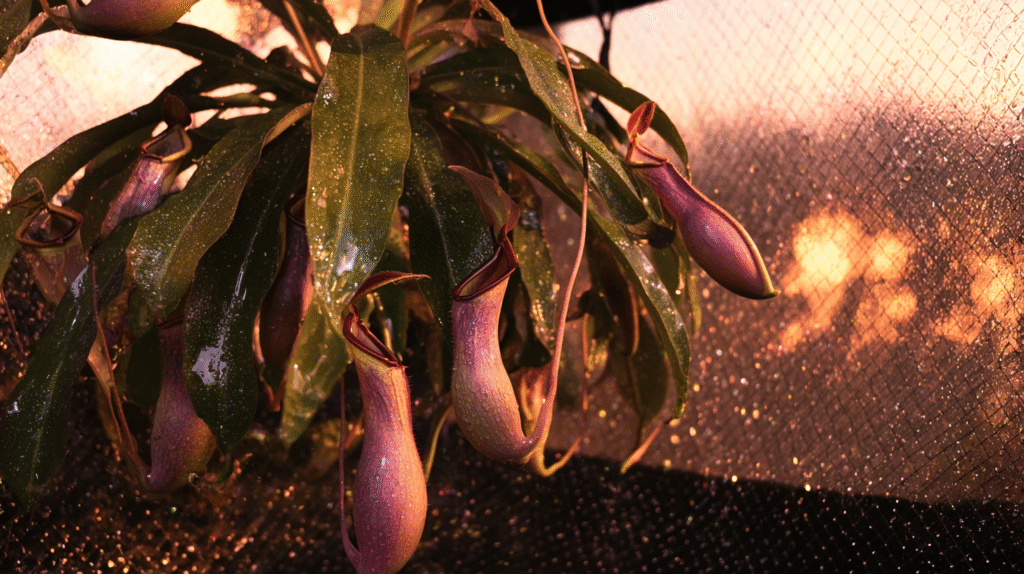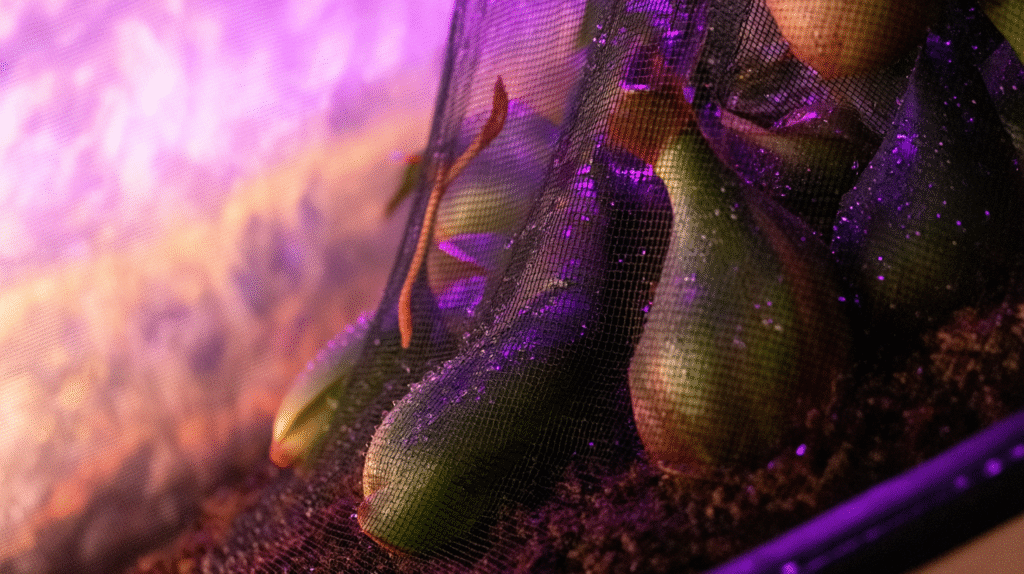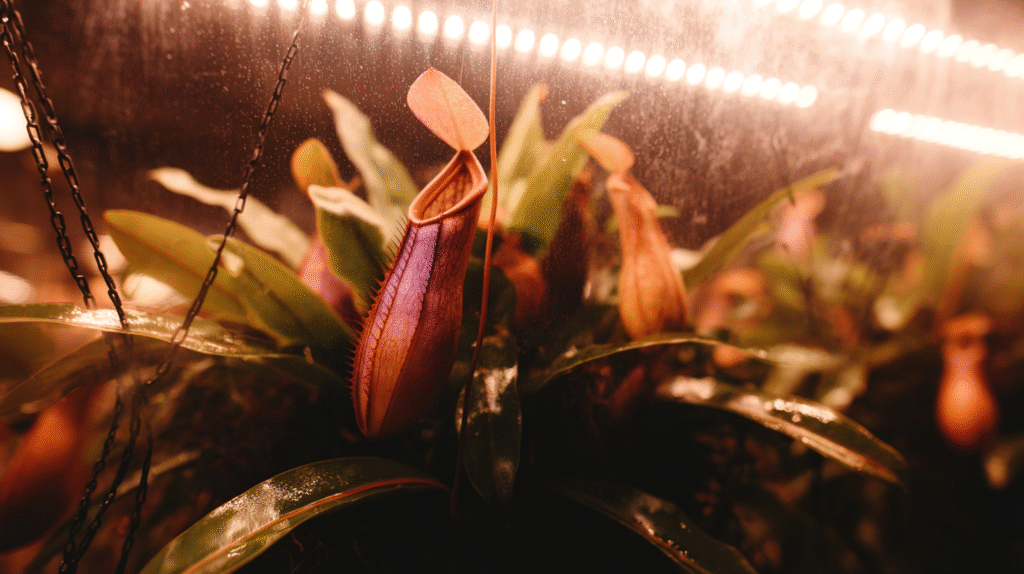My first Nepenthes looked like something from an alien planet — glossy leaves ending in elaborate pitcher traps dangling like Christmas ornaments. Three weeks later, those beautiful pitchers were brown husks, and the plant looked like it was staging a dramatic death scene in slow motion.
That $45 tropical pitcher plant was the beginning of an expensive education. Over eighteen months, I killed four Nepenthes, spent roughly $300 on plants and supplies, and questioned my sanity at least weekly. Why was I so determined to grow plants that clearly didn’t want to live in my house?
Because when you finally crack the code and watch a new pitcher develop from a tiny nub into a perfect trap, when your plant starts producing pitchers bigger than your fist, when visitors literally gasp at your collection — it’s worth every dead plant that came before. Here’s everything I learned the hard way about keeping these carnivorous divas happy.
Why Nepenthes Are Different From Other Carnivorous Plants
I thought my Venus flytrap success would translate. Wrong. Comparing Nepenthes to other carnivorous plants is like comparing orchids to dandelions. They’re in completely different leagues of difficulty.
What makes them special jerks:
- Need constant high humidity (60-80%)
- Want bright light but hate direct sun
- Require perfect air circulation
- Temperature sensitive depending on type
- Pitchers die if humidity drops for even a day
- Take forever to acclimate to new conditions
My first mistake was treating them like my Venus flytraps. Different plants, different continent, completely different needs.
The Highland vs. Lowland Drama
Nobody at the garden center mentioned this crucial detail: there are two main types of Nepenthes with opposite temperature needs.
Highland species:
- Want cool nights (50-65°F)
- Day temps 70-80°F
- From mountain regions
- Nearly impossible in normal homes
Lowland species:
- Prefer warm nights (65-75°F)
- Day temps 75-85°F
- From tropical lowlands
- Slightly more apartment-friendly
Guess which type I bought first? Highland. In my 72°F apartment. It died a slow, pitcher-less death. Now I stick to lowland or intermediate hybrids that don’t demand mountain weather.
The Humidity Battle That Nearly Broke Me
This is where most people (including me) fail spectacularly. Nepenthes want rainforest humidity in your desert-dry home.
What didn’t work:
- Misting (lasted 5 minutes)
- Pebble trays (raised humidity 5%)
- Bathroom placement (still too dry)
- Open terrarium (fungus festival)
What finally worked: Built a grow tent. Yes, I have a tent in my living room dedicated to carnivorous plants. Judge me all you want — my pitchers are magnificent.
My humidity setup:
- 2x2x4 foot grow tent ($80)
- Small humidifier inside ($30)
- Humidity controller ($35)
- Keeps steady 70-75% humidity
Without this setup, I was just slowly murdering expensive plants.

Light: The Goldilocks Nightmare
Too much light = burned leaves and no pitchers. Too little = no pitchers and stretched growth. They’re pickier than my cat about everything.
Where they failed:
- Direct sun: Leaves bleached, pitchers never formed
- Dark corner: Grew but no pitchers
- Regular LED bulbs: Survived but looked sad
Where they thrived:
- LED grow light in tent
- 12 hours daily
- 12-18 inches from plants
- Bright but indirect outdoor light
My best grower sits under a full spectrum LED that cost more than the plant. The investment paid off when it started producing 6-inch pitchers.
Water: At Least This Part’s Familiar
Like other carnivorous plants, they’re water snobs.
Requirements:
- Distilled or RO water only
- Keep soil moist but not waterlogged
- Never let them dry out
- No sitting in water trays like VFTs
I go through 3 gallons of distilled water weekly between all my carnivorous plants. It’s become a regular grocery item like milk.
The Soil Mix That Actually Works
After killing one in regular potting soil (rookie mistake), I learned they need airy, moisture-retentive media.
My mix:
- 40% long-fiber sphagnum moss
- 30% perlite
- 30% orchid bark
- Some people use pure sphagnum
The mix should hold moisture but never get soggy. Think orchid growing, not bog conditions.
Feeding: Easier Than Expected
Unlike Venus flytraps, you can actually help feed Nepenthes, and they respond well.
What works:
- Diluted MaxSea fertilizer in pitchers (1/4 teaspoon per gallon)
- Occasional insects
- Dried bloodworms from pet store
- One bug or feeding per pitcher monthly
What I learned:
- Don’t overfeed (pitchers die faster)
- They’ll catch their own bugs if outside
- Fertilizer misting helps plants without pitchers
- Fed plants grow noticeably faster
My largest N. ventrata grew twice as fast once I started the MaxSea routine.
The Pitcher Development Obsession
Watching pitchers develop becomes an addiction. It starts as a tiny nub at a leaf tip and slowly inflates over weeks.
Perfect pitcher conditions:
- Consistent high humidity
- Stable temperatures
- Good light
- No touching or moving
Why pitchers die:
- Humidity drops
- Overfeeding
- Natural aging (they last 1-3 months)
- Stress from environment changes
I’ve learned to celebrate each new pitcher because they’re proof I’m doing something right.
Common Problems I’ve Conquered
No pitchers forming:
- Usually humidity or light issues
- Sometimes needs more maturity
- Could be acclimation stress
Brown pitcher edges:
- Humidity too low
- Water quality issues
- Normal aging
Leaves yellowing:
- Often overwatering
- Sometimes needs food
- Check for root rot
Slow growth:
- Normal for Nepenthes
- They’re not fast growers
- Patience required
My Current Collection and Setup
After all the failures, I now successfully grow:
N. ventrata:
- The gateway drug
- Most forgiving hybrid
- Pitchers reliably
- Recommended for beginners
N. sanguinea:
- Beautiful red pitchers
- Slightly pickier
- Worth the effort
N. ‘Miranda’:
- Gets huge
- Spectacular pitchers
- Outgrowing my tent
All live in the grow tent with controlled conditions. It’s not the most attractive setup, but it works.

The Unexpected Benefits
Beyond the obvious cool factor of owning plants that eat bugs:
Fungus gnat control: They catch every gnat in my apartment. Better than sticky traps.
Conversation starter: Everyone wants to know about the tent with alien plants.
Meditation practice: Watching pitchers develop taught me patience I didn’t know I had.
Gateway to other plants: The controlled environment works for orchids and other tropicals too.
Why I Keep Growing These Demanding Plants
They’re not easy. They require equipment, special water, and constant monitoring. My electric bill went up. I have a grow tent as living room furniture. Friends think I’m slightly unhinged.
But when a new pitcher opens, when the light hits the peristome just right and it gleams like candy, when a visitor sees them and goes “What IS that?” — all the hassle disappears.
These aren’t just plants; they’re living sculptures that evolved an insane solution to nutrient-poor soils. They’re proof that nature is wilder than fiction. They’ve taught me patience, humility, and the importance of humidity controllers.
The Bottom Line on Tropical Pitcher Plants
Don’t start with Nepenthes if you want easy. Don’t start if you’re not willing to modify your living space. Don’t start if you can’t commit to distilled water and humidity management.
But if you’re fascinated by carnivorous plants, if you don’t mind a grow tent in your living room, if you have patience for slow growers that reward you with spectacular pitchers — dive in.
Start with N. ventrata. Accept that your first might die while you learn. Join online communities where people understand your obsession. And prepare to become that person who shows everyone photos of their pitcher plants like they’re grandchildren.
My Nepenthes journey started with expensive failures and frustration. Now I can’t imagine not having these weird, wonderful plants in my life. They’ve made me a better, more patient grower. Plus, I never have to worry about fungus gnats again.
Just maybe learn from my mistakes instead of repeating them. Your wallet will thank you. But honestly? You’ll probably kill at least one before succeeding. It’s basically a rite of passage in the carnivorous plant world. Welcome to the obsession. 🪴







